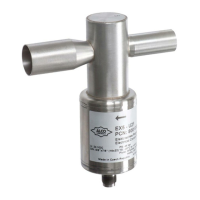Safety
Information
Introduction Installation
PowerTools
Pro Software
Communications
How
Motion
Works
How I/O
Works
Configuring
an
Application
Programming
Starting and
Stopping
Motion
Starting and
Stopping
Programs
Parameter
Descriptions
Drive
Parameters
Used by
EZMotion
Diagnostics Glossary Index
EZMotion User/Programming Guide 165
Revision A8 www.controltechniques.com
9.8.2 Program Math Functions
ArcSin
This trig function can be used in formulas from within a program. Example: var.var0 = ArcSin(var.var1). Returns the
trigonometric ArcSin in degrees. The ArcSin is the angle whose Sine is the given number.
ArcTan
This trig function can be used in formulas from within a program. Example: var.var0 = ArcTan(var.var1). Returns the
trigonometric ArcTan in degrees. The ArcTan is the angle whose Tan is the given number.
ArcCos
This trig function can be used in formulas from within a program. Example: var.var0 = ArcCos(var.var1). Returns the
trigonometric ArcCos in degrees. The ArcCosine is the angle whose cosine is the given number.
Cos
This trig function can be used in formulas from within a program. Example: var.var0 = Cos(var.var1). Returns the
trigonometric cosine in degrees. Cos(x) x is in degrees and accurate to 6 decimal places.
Modulus
Returns the remainder (Modulus) resulting when a numerator is divided by a denominator. The result has the same sign as the
denominator. The floating-point operators are NOT rounded to integers as would be in the Mod operator.
The exact mathematical function for the Modulus function is as follows:
Modulus(x,y) = x - [(FLOOR (x/y)) * y]
Where FLOOR is defined as rounding the argument down to the next whole integer value towards negative infinity.
Example: FLOOR(-3.5715) = -4 or FLOOR(3.5715) = 3
The FLOOR function itself is not available to the user within a user program.
Example 1: Modulus(5,1.4) Returns 0.8
Example 2: Modulus(5,-1.4) Returns -0.6
Example 3: Modulus(-5,1.4) Returns 0.6
Example 4: Modulus(-5,-1.4) Returns -0.8
Sin
This trig function can be used in formulas from within a program. Example: var.var0 = Sin(var.var1). Returns the
trigonometric sine in degrees. Sin(x) x is in degrees and accurate to 6 decimal places.
Tan
This trig function can be used in formulas from within a program. Example: var.var0 =Tan(var.var1). Returns the
trigonometric tangent in degrees. Tan(x) x is in degrees and accurate to 6 decimal places.
9.8.3 Program Array Access
Cam[ ].Follower
This instruction allows the user to write a value to a specified cam table follower element number. In the following example
Cam table 1, follower element 2 will be changed to the value of 3.
Example:
Cam[1,2].Follower =3
Cam[ ].Interpolation
This instruction allows the user to write a value to a specified cam table follower element number. In the following example
Cam table 1, Interpolation element 2 will be changed to the value of 3.
Example:
Cam[1,2].Interpolation =3
Cam[ ].Master
This instruction allows the user to write to a specified cam table master element number. In the following example: Cam table
0, master element 3 will be changed to 7.
Example:
Cam [0,3].Master=7
9.8.4 Motion Instructions
Dwell For Time
This motion instruction is used to pause program execution for a very precise amount of time.
It operates as a motion instruction - similar to an index, home or jog. Like all other motion instructions it will not start until the
preceding motion instruction has completed. A "Wait for Index.AnyCommandComplete" is not required. Likewise, any
subsequent motion commands will wait and start after the dwell has completed. The total time required to complete a
sequence of indexes and "Dwell For Time" instructions is extremely repeatable.
The "Dwell For Time" instruction is in units of seconds with a resolution of milliseconds (0.000 seconds).
If you want to pause the program while an index is executing you should use a Wait for Time instruction described below.
A comment is automatically inserted after the Dwell For Time instruction that notes that the dwell time is in units of seconds.
The comment starts with the apostrophe ' character.

